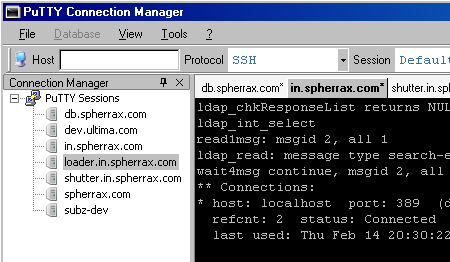PuTTY Tabs
I have been using the PuTTY Telnet / SSH client for a long time, but I have always lacked tabs in it. Developers complain that, for the introduction of tabs, it is necessary to completely rewrite the entire GUI of the application, and we don’t see any valid reasons for changing the concept of a lightweight client. So the task has been hanging in the pool of improvements with a low priority status for a long time. Suffering users write a petition to the developers, and especially the “handy” ones hang all sorts of wrappers on PuTTY.
In search of a tolerable solution, I came across quite a worthy candidate: PuTTY Connection Manager (current version: beta 0.6.0.4822, freeware, no source)

')
Platform: C #, .NET Framework 2.0
OS: x32 Windows XP SP1 / SP2, Vista, 2000
The developer went in a simple way: he wrote a wrapper that embeds the graphic instances of PuTTY into the application's tabs. In this regard, there are some difficulties with the focus of the windows: when putty is active, the focus is removed from the manager’s window, and vice versa. The current solution (the alt + shift keystroke changes the focus between the wrapper and the terminal) is generally quite reasonable and does not cause any inconvenience when working.
From pleasant
What embarrassed
At first, I didn’t understand why the author didn’t add a hotkey to close the tab, later he realized that everything was ready in PuTTY: the Ctrl + C or Ctrl + D combination closes the connection and the terminal. True, dead compounds still have to be closed with the mouse.
In general, the application was like - a promising start. I hope the developer will not stop developing it and bring it to a stable release =)
In search of a tolerable solution, I came across quite a worthy candidate: PuTTY Connection Manager (current version: beta 0.6.0.4822, freeware, no source)

')
Platform: C #, .NET Framework 2.0
OS: x32 Windows XP SP1 / SP2, Vista, 2000
The developer went in a simple way: he wrote a wrapper that embeds the graphic instances of PuTTY into the application's tabs. In this regard, there are some difficulties with the focus of the windows: when putty is active, the focus is removed from the manager’s window, and vice versa. The current solution (the alt + shift keystroke changes the focus between the wrapper and the terminal) is generally quite reasonable and does not cause any inconvenience when working.
From pleasant
- switchable tabs
- hotkeys, combinations of which can be changed in the settings
- full screen mode F11
- connection manager
- quick connect panel
- auto update
What embarrassed
- the wrapper turned out to be a bit heavy: it takes a long time to load, but by itself it works smartly
- there is a hot key to switch to the F3 netlist, but the intuitive launch of the terminal from the keyboard does not work with the Enter key - you have to pervert
- management of separate connection databases from the PuTTY registry. I still do not understand where it can be useful to me
- in the quick connect panel is the default telnet protocol
- does not save the position of the connection manager from the last session
At first, I didn’t understand why the author didn’t add a hotkey to close the tab, later he realized that everything was ready in PuTTY: the Ctrl + C or Ctrl + D combination closes the connection and the terminal. True, dead compounds still have to be closed with the mouse.
In general, the application was like - a promising start. I hope the developer will not stop developing it and bring it to a stable release =)
Source: https://habr.com/ru/post/20302/
All Articles